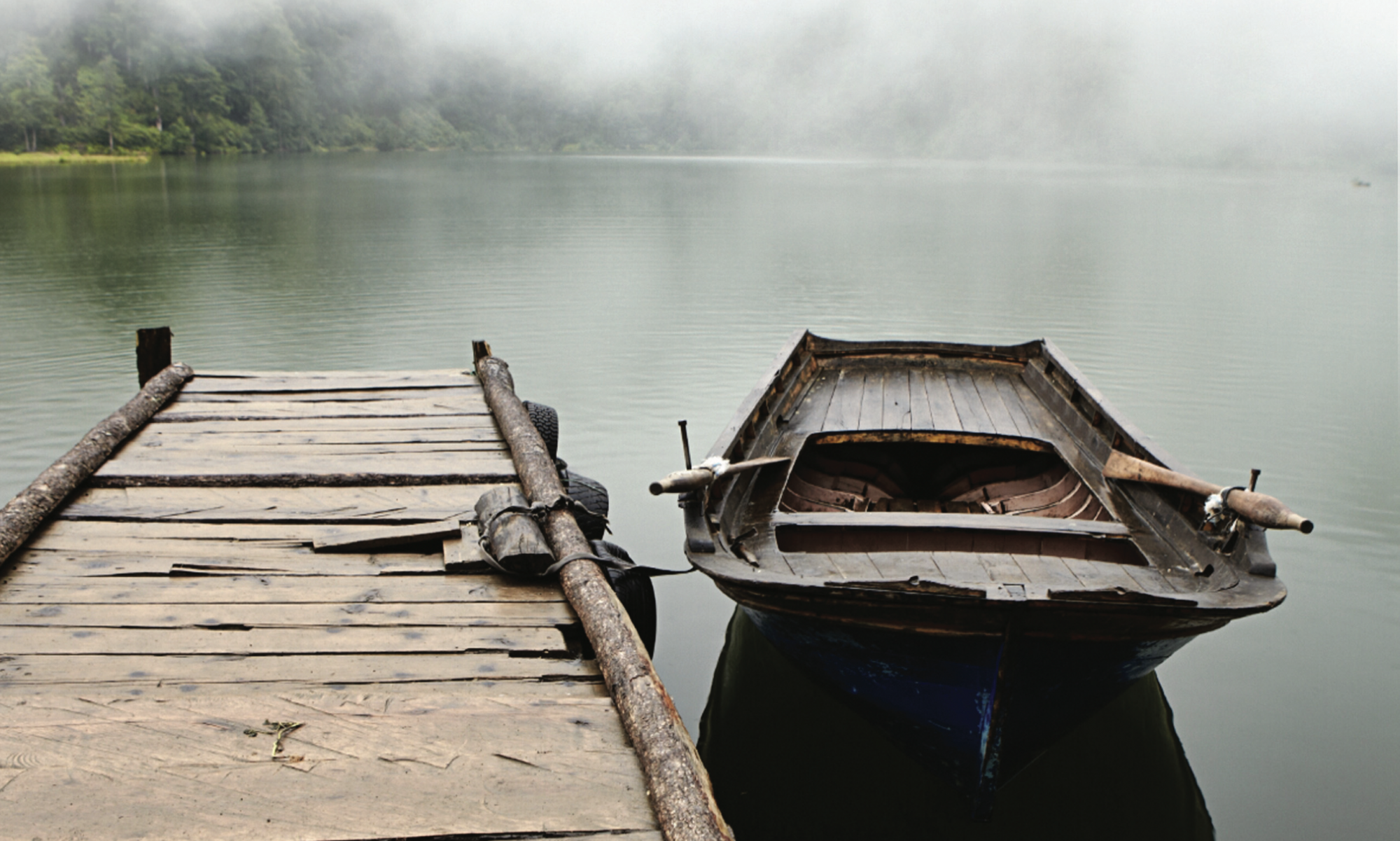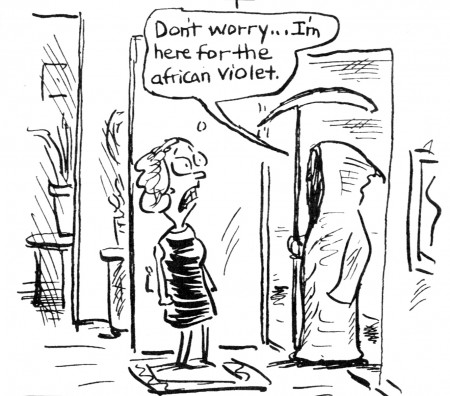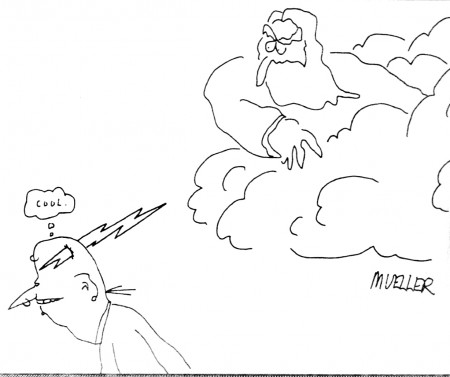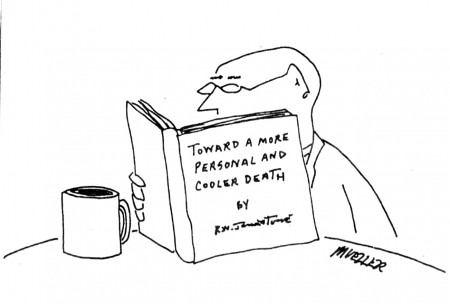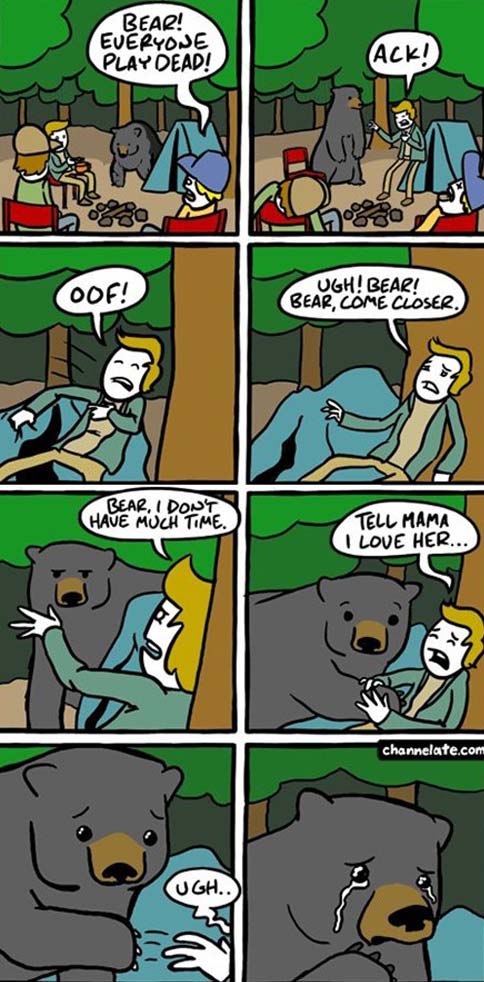Humor takes the sting away; it humanizes us; it helps us keep our perspective. Humor enriches us; it educates us; it brings us joy. Humor doesn’t dissolve the pain or make our life any less poignant, but it does help make things more bearable. That’s my philosophy, and I’m happy to share it with you on a weekly basis. I hope that if you enjoy what you see, you will take the opportunity to share it with others.
Right to die: Dr Rodney Syme hands patient Ray Godbold life-ending medication
A small brown bottle of liquid sits on the table, positioned between the two men.
The glass has no label, but both the patient and the doctor know what it holds.
Cancer sufferer Ray Godbold, left, meets Dr Rodney Syme, of Dying with Dignity Victoria. Photo: Justin McManus
The sick man calls it “control” and the urologist calls it “medication”, but the non-prescription substance has another name.
Nembutal was once a common sedative but is now more often used by vets to put pets to sleep. It is also the drug of choice for those who believe in the “right to die” – when physical pain and emotional misery become too much to bear.
Ray Godbold, 59, wipes his runny nose and explains what has led him from his home in Inverloch to this Philip Island holiday shack, surrounded by chittering birds perched in coastal banksias.
He has come to meet with Dr Rodney Syme, 79, the controversial vice-president of Dying with Dignity Victoria, to discuss the final stage of his life and his control over how those minutes unfold.
They first met here 12 months ago. Godbold had stage four gastroesophageal cancer, which had spread to his liver and lymph nodes. They kept in touch as the disease progressed. Now they are back.
Reasons for concern have been mounting. The cancer is taking more of his metabolism away, along with his appetite and energy. His pain and discomfort are growing, with dizzy spells and a few falls.
“I can tell – in myself – that the cancer will eventually…” he pauses, stopping to gather his thoughts. “I’m not as well as I have been.”
Both men know how his disease will progress from here.
Catastrophic events such as a heart attack, pulmonary arrest, embolism or severe bleeding are a risk. Liver failure and jaundice are a concern and, as the cancer spreads, cachexia or “wasting”.
“If I was here in my underwear, you would see the ravages of the cancer on my body,” says Godbold. “If I took my clothes off, you would say I was already cachetic.”
Godbold talks the talk because he spent 34 years as a nurse. As a midwife, he has been in the delivery room for the arrival of so many newborns, and he has also been present in homes and hospices as countless others have died in his specialist palliative care.
Godbold knows what a bad death looks like, and he does not want that for himself or his loved ones. And so he wants that little brown bottle on the table. He wants control.
He does not want to meet any new doctors or nurses in his final days. He does not want a drip of morphine and Midazolam to send him into a coma.
He does not want strangers making decisions about his death while he is unconscious, while his family sits for hours, days or even weeks – waiting for his last breath.
He has been positive up until now, but new metastases have come up and there is a creeping “existential despair” about how the end will come.
“My thoughts are starting to get a little bit darker, about death approaching,” he says. “I have had a psychological change.”
Rodney Syme nods. He points out that doctors cannot measure pain, breathlessness or tiredness. They cannot quantify despair and therefore must accept that only the patient can judge when suffering becomes insufferable.
He has been helping people in this situation for 25 years, by doing what he is about to do.
He hands the bottle over.
“That’s medication for you – some Nembutal,” he says. “You need to take that by mouth, and you will have total control of that. It’s not my intention that you take it. I hope you don’t need to take it. But if you run into a brick wall, then that is what I sometimes call the key to the fire escape.”
The two men shake hands and begin discussing the efficacy of what is, in effect, a black market substance. Nembutal is a “border controlled drug”, possession of which is a breach of law. Penalties range from imprisonment to fines of up to $825,000.
“If you take it,” says Dr Syme, “you will go to sleep relatively quickly and peacefully, and you will not wake up.”
If Godbold ingests the powerful barbiturate, he will be able to talk to his family for a few minutes, but the conversation will slow. He might yawn deeply, lying there in his bedroom. He will close his eyes at times, and drift into sleep.
In unconsciousness, the drug will slow his brain activity and nervous system. His heart rate will weaken. His breathing will become shallow. He will be dead in perhaps 20 minutes.
“Thank you,” he says. “It gives me great peace of mind to know that I’ve got it in my possession. I very much appreciate what you’re doing for me.”
What both men are doing is taking a stand. They are mounting a public challenge to current laws that deny people the right to take their own life with the help of a doctor, through medication that can assist their passing in a peaceful and reliable way.
They expect a reaction. They want a debate – about what Dr Syme has already done for decades.
Paul Russell, director of HOPE, an organisation devoted to preventing euthanasia and assisted suicide, said it was “frustrating” that any doctor would supply patients with life-ending medication. “Euthanasia is never safe.”
One of his main arguments against “right to die” legislation is the inevitable “incremental extension” of those laws. In the Netherlands and Belgium, he says, people have been euthanised after psychiatric illnesses, botched sex change operations, or fear of going into a nursing home.
The story of Ray Godbold creates an “impetus for change”, he says, but equally there are other stories that should create “cause for pause or thought”.
In Victoria, it is a criminal offence to incite, aid or abet a suicide, with a maximum penalty of five years’ jail, yet no Victorian doctor has been charged with assisting suicide in the past 50 years.
Dr Syme says he has been “frightened” to publicly reveal his work as it might get him into “deep trouble”, but says the time for hiding has passed.
State Parliament has rejected 16 euthanasia bills over the past 20 years, and although a new inquiry into end of life choices has been launched, Dr Syme feels the issue needs a push.
He is happy to make his actions known, and is even delivering an address on the subject to the annual conference of the Royal Australasian College of Physicians later this month.
Offering people this kind of control, he says, helps relieve angst and potentially extends life by removing anxiety about death. Then finally, as a last resort, medication can be a way out of a protracted and gruesome passing.
“I’ve set out to challenge whether what I am doing here publicly is a criminal offence,” he says. “I believe I can argue that it’s not – that it’s good palliative medicine.”
Ray Godbold is a believer in palliative care. He knows it may be enough for him, as it was for right to die campaigner Peter Short.
But he does not want to be forced to rely on their restrictive processes when the end of his “mortal cycle” is near – when he believes he should have a choice.
“When it comes to the end of my life,” Godbold says, “my trust is with myself.”
In the meantime, he is painting the house, bedding down the garden for winter, and making sure there are no odd jobs left behind when he is gone.
He wants to be ready for that moment, in every way.
“I want to gather my family around me and just say goodbye, and go my way – not your way,” he says. “Now’s the time.”
Complete Article HERE!
Catawba students examine death and dying in honors class
Most college students arrive on campus expecting to live a long, long life and planning to take courses focusing on the ways that humans live and think, knowing, as Socrates says, “the unexamined life is not worth living.” It might come as a surprise, then, that this spring 19 honors students at Catawba College chose to take a course entitled “Joining the Choir Invisible: On Death and Dying.”

Team-taught by English professor Dr. Janice Fuller and psychology professor Dr. Erin Wood, this honors course was designed to explore the biological, psychological, religious, and sociological phenomena at work when humans die and prepare to die. The course also explored postmortem realities, including how various societies treat human remains and memorialize the dead.
The course was structured around texts and films from a variety of disciplines, ranging from “How We Die” by neurosurgeon Sherwin Nuland, “Final Gifts” by hospice nurses Maggie Callahan and Patricia Kelley, and journalistic works on cadavers and American ways of memorializing the dead. The class also analyzed films like “Harold and Maude” and “Afterlife” and the television series “Six Feet Under” as texts to help them examine and develop their attitudes toward death.
Yet it may have been through experiential learning that the students most directly encountered dying and death.
Hospice volunteer and poet Michael Gaspeny spoke to the class about his closeness with patients faced with end-of-life decisions. Gaspeny’s stories brought the reality of working with distinctive dying patients to life.
“Everyone is an individual until that person disappears from this earth,” Gaspeny began. To make his point, he shared a few of his award winning poems about his hospice patients.
“People die as they live,” Gaspeny said.
Students visited UNC Chapel Hill’s Exercise Science cadaver lab where they viewed two cadavers donated to the lab for the advancement of science. Despite the chilly room and chemical smell the students remained eager to have a hands-on experience with the cadavers.
“At one point I was able to hold the brain of one of the cadavers,” said Kala Byrd of North Wilkesboro.
The cadaver lab gave her an understanding of how simple yet complex the human body really is and what death takes away from the living person.
The visit to the cadaver lab prepared the students to read Marianne Boruch’s “Cadaver, Speak,” a 32-section poem written in the voice of a 99-year-old cadaver Boruch observed in Purdue University’s Gross Anatomy lab. After reading the poem, the students presented the poem through a theatrical reading that was open to the public.
The staging caused students to have vivid memories of the cadavers they had personally observed at the UNC lab and helped bring the poem’s 99-year-old cadaver to life. Sara Sellers of Salisbury commented that Boruch “presents this cadaver as a person who has a past and who has memories. The beauty in this is that the 99-year-old lived a full life before death. Death is better than not ever existing.”
On a chilly Saturday in March, the class took a field trip to local graveyards. These cemeteries gave the students insight into local traditions and values followed in honoring loved ones in distinctive ways.
“I was rather shocked by how much I loved the Salisbury National Cemetery. I am a staunch believer in individuality when it comes to after-death plans … (yet) I admired the uniformity of all of the headstones … These soldiers were a united force that fought for a common goal and that unity is still on display after death,” Michael Jones of Salisbury wrote.
For the final paper, students outlined the end-of-life plans that they might want to make, using Aging with Dignity’s document “Five Wishes.”
At the beginning of the class, many students expressed anxiety about the fact of death. Some admitted being unable to conceive of really dying – an idea that Jo Ann Beard expresses in her essay “Undertaker Please Drive Slow.”
“It is impossible to imagine not existing because in order to imagine you must exist,” Beard said.
And yet imagine and plan and enact death the Honors students did. Perhaps, after all, the unexamined death is not worth – well, dying.
Complete Article HERE!
Tech-savvy baby boomers living death to the fullest
By Chris Johnston

This week at the Bunurong Memorial Park – a big cemetery out near Dandenong – earthmovers were starting to build a road to an on-site redgum forest which, in less than a year, will host the newest of Australia’s new-age burials.
Forest or ‘woodland’ burials on the grounds of existing cemeteries, with the body in a shroud or light covering, are also gaining popularity in other states.
It is seen as a more natural or environmentally friendly option than being buried deep down in a heavy coffin – especially for the technologically savvy, environmentally friendly and wealthy baby boomers, who will soon start dying.
From early next year at the revamped Bunurong, families of those buried in the redgums with no gravestone and moss and grass growing over them in time will be able to track the body by GPS.
The ten-cent-coin-sized GPS trackers will be encased in a plastic capsule and attached to the shroud. As the shroud and body decompose the tracker remains in the ground and visitors can find the burial site through an app on a mobile phone or other device.
New trends in burial and memorialisation will become more common as the generation that says it changed life also goes about changing death. The oldest post-war baby boomers – born between 1946 and 1964 – are now 69. Their demise is, if not imminent, then at least looming.
And it will be a busy time for the death industry. According to veteran Sydney funeral director Dale Maroney, the chief executive officer of Walter Carter Funerals, it will be “a boomtime – the work has to come.”
According to Bunurong’s chief executive officer Jane Grover the death of the baby boomers will be “a 20-year cycle of significantly increased death rates.” There are 5.5 million baby boomers in Australia holding 40 per cent of the country’s personal wealth. By 2020 it is forecasted that half the country’s population will be over 65. Advances in medicine and better lifestyles mean they will live longer but when they begin dying it will be in big numbers.
“The industry has been waiting a while and we are still waiting,” says Maroney.
Industry leaders say that traditional methods of interment and memorialisation will fade away as the more adventurous, emotionally intelligent baby boomers face death. This is why Australian cemeteries like Bunurong, Lismore Memorial Park in New South Wales and Kingston in Hobart are getting ready for them now.
In Victoria, since 2010, cemeteries on Crown Land need to be self-sufficient as not-for-profit enterprises. They get no state money. A traditional burial with headstone costs between $3500 and $20,000. A cremation, more popular but environmentally less friendly, costs around $1000. A so-called ‘green burial’ in a shroud under a cemetery tree will cost around $4500 at Bunurong from next year, according to Grover.
She says while older generations tended to be only concerned with the “mechanics” of death – a “just bury me” attitude – younger baby boomers are more interested in “the art of dying well.”
Guilt over environmental issues such as climate change during their lifetime contributes to demand for ‘green burials,’ she says.
As well as the GPS trackers, discrete bird boxes on trees denoting burial sites are available. The road in to the Bunurong redgum stand will be kept as dirt, Grover says, to give a feeling of “authentic and undisturbed” forest. She says the burials would be shallow at 1.2 metres which allows better decomposition. Bodies in heavy caskets buried deep tend to putrefy rather than decompose.
Sydney’s Dale Maroney says QR readers (similar to a barcode) are also tipped to be popular. At headstones or burial sites visitors can scan the code and get data or information on the dead person relayed to devices. The time between death and a funeral is also expected to lengthen as baby boomers begin to die and funerals and interments become more informal but also more technologically complex.
“Baby boomers broke the rule book through things like gender politics, the pill and conscription,” Grover says. “They have a sense of freedom and that is true even in death.”
Complete Article HERE!
Death Makes Life Possible – Redefining Attitudes Towards Death and Dying
Newly Released Book and Documentary by Social Anthropologist, Marilyn Schlitz, Ph.D., Explore How to Transform Our Fear of Death into New Models for Living & Dying.
What if contemplating and facing our mortality allowed us to live our lives more fully, without fear? In the newly released film and companion book Death Makes Life Possible, Dr. Marilyn Schlitz, PhD, presents a wealth of teachings and practical guidance on how to turn this taboo topic into a source of peace, hope, connection, and compassion.
“Our beliefs about what happens when we die define how we live today. And more and more of us are discovering a radical truth: when we release our fear of death, we open to an immensely richer life right here and now.” says Dr. Schlitz.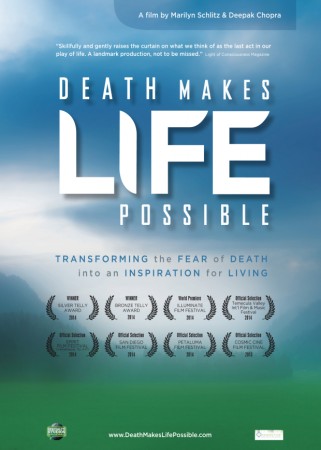
Rich in scientific investigation and varying worldviews, the book and film feature eminent scientists and scholars, spiritual leaders, devout skeptics, health practitioners, and people from all walks of life, revealing the myriad ways that we grow and change by expanding our perspectives on the ultimate mystery facing each one of us.
The timeliness of this topic is highlighted by the more than 10,000 baby boomers reaching the age of sixty-five every day in the United States alone. By 2040 the number of people turning 65 is calculated to hit 1.3 billion worldwide. However death is not a topic reserved for the elderly since it is something everyone will eventually face. These works invite us to address our views about death and to examine our beliefs about what we think will happen next.
“As we seek to transform our views on death,” says Dr. Schlitz, “we can build new perspectives on our mortality that redefine who we are and what we are capable of becoming.”
Death Makes Life Possible release date: May 1st, 2015. Executive Producers are Marilyn Schlitz and Deepak Chopra. The film is distributed by Specialty Studios. The book is published by Sounds True Publishing.
ABOUT THE AUTHOR
Marilyn Schlitz, PhD, is a social anthropologist, writer, and speaker who has been a leader in the field of consciousness studies for more than three decades. The author of Consciousness and Healing (Elsevier, 2004; with Tina Amorok and Marc Micozzi) and Living Deeply (New Harbinger, 2008; with Cassandra Vieten and Tina Amorok), she serves as president emeritus and a senior fellow at the Institute of Noetic Sciences. Dr. Schlitz lives in California. See marilynschlitz.com.
THE BOOK
Death Makes Life Possible – Revolutionary Insights on Living, Dying and the Continuation of Consciousness by Marilyn Schlitz / Sounds True / May 1, 2015 / Paperback / 233 pages / ISBN: 978-1-62203-416-1 / ebook ISBN: 978-1-62203-453-6 / US $17.95 / Self-Help, Death and Dying / World Rights
THE FILM
Death Makes Life Possible – Transforming the Fear of Death into an Inspiration for Living by Marilyn Schlitz / Specialty Studios/ Digital Release / May 1st, 2015 : Amazon / DVD – Educational & Community Screening Licensing: deathmakeslifepossible.com
